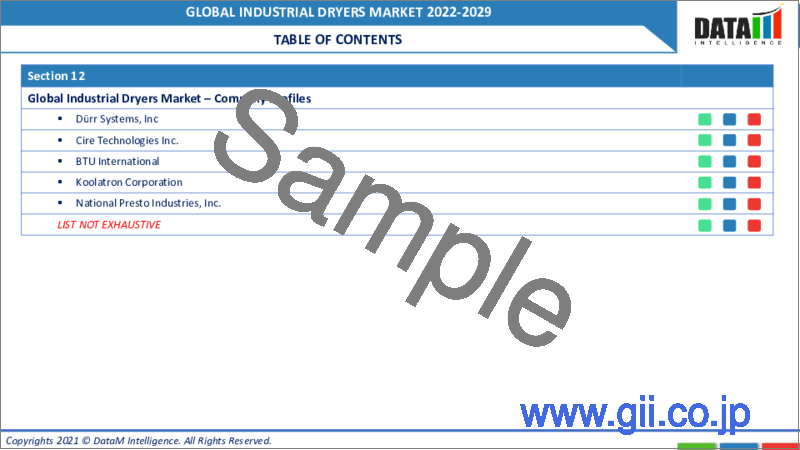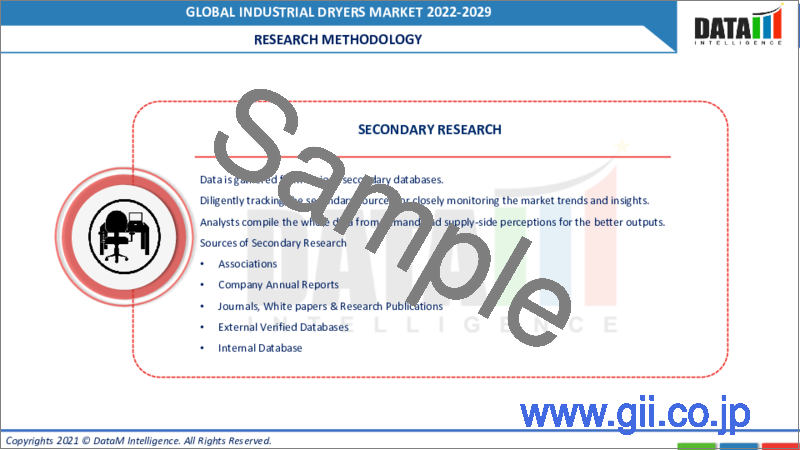|
|
市場調査レポート
商品コード
1074202
産業用乾燥機の世界市場(2022年~2029年)Global Industrial Dryers Market - 2022-2029 |
||||||
|
● お客様のご希望に応じて、既存データの加工や未掲載情報(例:国別セグメント)の追加などの対応が可能です。 詳細はお問い合わせください。 |
|||||||
| 産業用乾燥機の世界市場(2022年~2029年) |
|
出版日: 2022年05月07日
発行: DataM Intelligence
ページ情報: 英文 200 Pages
納期: 約2営業日
|
- 全表示
- 概要
- 目次
当レポートでは、世界の産業用乾燥機市場について調査分析し、市場力学、業界分析、市場分析、競合情勢など、体系的な情報を提供しています。
目次
第1章 世界の産業用乾燥機の調査手法と範囲
- 調査手法
- 調査の目的と調査範囲
第2章 世界の産業用乾燥機市場-市場の定義と概要
第3章 世界の産業用乾燥機市場-エグゼクティブサマリー
- 市場の内訳:製品別
- 市場の内訳:タイプ別
- 市場の内訳:アプリケーション別
- 市場の内訳:地域別
第4章 世界の産業用乾燥機市場-市場力学
- 市場に影響を与える要因
- 促進要因
- 抑制要因
- 市場機会
- 影響分析
第5章 世界の産業用乾燥機市場-業界分析
- ポーターのファイブフォース分析
- サプライチェーン分析
- 価格分析
- 規制分析
第6章 世界の産業用乾燥機市場-COVID-19分析
- 市場でのCOVID-19の分析
- COVID-19以前の市場シナリオ
- 現在のCOVID-19の市場シナリオ
- COVID-19以後の市場シナリオ/将来の市場シナリオ
- COVID-19における価格の力学
- 需要と供給のスペクトル
- パンデミック時の市場に関連する政府のイニシアチブ
- メーカーの戦略的イニシアチブ
- 結論
第7章 世界の産業用乾燥機市場:製品別
- イントロダクション
- 市場規模分析および前年比成長分析(%):製品別
- 市場魅力指数:製品別
- 直接*
- イントロダクション
- 市場規模分析および前年比成長分析(%)
- 間接
- 特殊
第8章 世界の産業用乾燥機市場:タイプ別
- イントロダクション
- 市場規模分析および前年比成長分析(%):タイプ別
- 市場魅力指数:タイプ別
- 流動層乾燥機*
- イントロダクション
- 市場規模分析および前年比成長分析(%)
- ロータリー乾燥機
- フラッシュ乾燥機
- 凍結乾燥機
- 噴霧乾燥機
- 熱伝導式乾燥機
- 赤外線乾燥機
- その他
第9章 世界の産業用乾燥機市場:アプリケーション別
- イントロダクション
- 市場規模分析および前年比成長分析(%):アプリケーション別
- 市場魅力指数:アプリケーション別
- 製紙用パルプ*
- イントロダクション
- 市場規模分析および前年比成長分析(%)
- 食品
- 肥料
- 化学
- 建設
- 製薬
- 鉱業
- その他
第10章 世界の産業用乾燥機市場:地域別
- イントロダクション
- 市場規模分析および前年比成長分析(%):地域別
- 市場魅力指数:地域別
- 北米
- 欧州
- 南米
- アジア太平洋
- 中東とアフリカ
第11章 世界の産業用乾燥機市場-競合情勢
- 競合シナリオ
- 市場ポジショニング/シェア分析
- 合併と買収の分析
第12章 世界の産業用乾燥機市場-企業プロファイル概要
- Carrier Vibrating Equipment, Inc*
- 企業概要
- タイプポートフォリオおよび説明
- 主要ハイライト
- 財務概要
- Metso Corporation
- Flsmidth & Co. A/S
- Buhler Holding AG
- Anivi Ingenieria SA
- Durr Systems, Inc
- Cire Technologies Inc.
- BTU International
- Koolatron Corporation
- National Presto Industries, Inc.
第13章 世界の産業用乾燥機市場-重要考察
第14章 世界の産業用乾燥機市場-DataM
- 付録
- 当社・サービスについて
- 問い合わせ先
Market Overview
The global industrial dryers market reached US$ XX million in 2021 and is expected to reach US$ XX million by 2029, growing at a CAGR of XX% during the forecast period (2022-2029).
A machine that removes liquid or moisture from bulk materials is known as an industrial drier. Industrial dryers are far larger than domestic dryers and should not be mistaken for at-home laundry dryers or industrial hand dryers. Water treatment, air pollution management, food processing, paper & pulp, agriculture, pharmaceuticals, plastics, and industrial production are just a few industries that rely extensively on industrial dryers.
Industrial dryers are used to dry substances and products such as trash, sludge, dairy products, grain, paper, plastics, fertilizer, and chemicals in these sectors. Industrial dryers are not utilized as laundry equipment unless they are enormous dryers put in a laundromat or a hotel. Sometimes, dryers also engage in sublimation when a solid changes directly into a gas. The dryers perform drying action using air, spray, and infrared drying methods. Of these, air drying is the most common. It works simply by bringing dried materials into direct contact with cold or hot air. Examples of cold and hot air dryers include fluidized bed dryers, rotary dryers, flash dryers, and freeze dryers.
Dryers can also engage in sublimation, transforming a solid into a gas. The dryers use one of three drying methods: air drying, spray drying, or infrared drying. The most popular method is air drying. It works by bringing the things to be dried into direct contact with either cold or hot air. Fluidized bed dryers, rotary dryers, flash dryers, and freeze dryers are examples of cold and hot air dryers.
Market Dynamics
The global industrial dryers market is expected to boost with rising demand from the mining sector to increase production efficiency.
Rising demand from the mining sector to increase production efficiency
Drying is vital for mineral processing; managing moisture content helps reduce shipping costs, optimize downstream processing, and produce a refined product. Mineral dryers, while similar to other industrial dryers in appearance, are typically built to withstand more rigorous demands than many other industries; due to the nature of minerals, mineral dryers are subjected to consistently harsh processing conditions, necessitating a dryer with heavy-duty components and materials of construction.
Anthracite, bituminous, sub-bituminous, and lignite coals can vibrate fluid bed dryers. It uses vibration to improve fluidization and transfer bigger particles, even if they are sticky or dusty. For finely crushed coal, conventional static fluid bed dryers are designed to dry the product thoroughly with in-bed heat exchangers.
Rotary dryers are the choice for mineral drying applications. Mineral drum dryer design varies based on the unique characteristics of the mineral to be processed. In general, however, one can assume that a dryer intended for mineral processing will meet certain objectives required by the industry.
In 2020, Lynas received a 14-meter industrial-scale dryer at the Mt Weld rare earth deposit in Western Australia to improve production efficiency. The kiln-dryer has been installed to enhance the efficiency of producing rare earth concentrate and substituting manual drying of concentrate in the sun. The dryer is also expected to bring cost savings and faster processing to Mt Weld, helping reduce moisture levels before shipping. It results in improved materials handling, lower freight costs and enhanced productivity.
Hazards related to fire & Explosion
Industrial dryers have high chances of fire and explosion due to various reasons, impacting the market growth. When a burning dust/air mixture is confined inside a vessel, such as a dryer, the hot combustion products' expansion is stifled and pressure rises, resulting in an explosion. Depending on the qualities of the material, heat or mechanical sparks generated by friction may have enough energy to ignite flammable powder/dust clouds or layers. When drying equipment has moving elements, such as rotary, conveyor, or trough dryers, fire sources are a concern.
Misaligned parts or overheated bearings, tramp metal entering the dryer, and the material itself are all sources of friction inside a dryer. The industries have witnessed an increased number of projects in recent times. For instance, In 2021, A fire inside an industrial dryer happened in Bristol Township's Croydon section. Boxes of a powder being dried caught ablaze. Moreover, in 2021, The South Bend Ethanol Plant in South Bend caught fire due to the dryer at the site.
COVID-19 Impact Analysis
The industrial dryer market has been stable during the COVID-19 pandemic. The dryers have important applications in diverse industries, in which some of the sectors faced uplift, while others faced downfall. The demand for industrial dryers in the pharmaceutical and food industry has grown tremendously. However, the market faced a decline in various major industries, including mining, cement, paper & pulp, and others. As the COVID-19 outbreak has slowed construction in many countries, the industry has seen lower demand for its products, leading to overcapacity. During the pandemic, overcapacity made the cement sector vulnerable to a sudden drop in demand. Companies have been operating at lower production rates, significantly affecting production and revenue. The mining industry in various countries has to face huge losses during the covid-19 outbreak. Mexico's mining chamber has estimated that mining output in the country is expected to fall by around 17% in 2020; Coal India proclaimed an 11.2% decline in production in May 2020 compared with May 2021 and Minerals Council South Africa has estimated that mining output in the country is expected to fall by 8- 10% this year.
Segment Analysis
The global industrial dryers market is segmented based on product, type, application, and region.
High efficiency in drying fine powder particle sizing from 10 to 2000 mm will boost the demand for fluidized bed dryers
Based on type, the global industrial dryers market is segmented into fluidized bed dryers, rotary dryers, flash dryers, freeze dryers, spray dryers, conduction dryers, infrared dryers, and others.
Fluidized bed dryers provided effective solid mixing, rapid heat and mass transfer, and material conveyance. Fluidized bed dryers are more appropriate for drying fine powder particle sizing from 10 to 2000 mm than conventional drying methods. Fluidized bed dryers have numerous advantages, including uniform final moisture content, greater drying capacity due to better mass and heat transfer, higher temperatures, and higher quality products. Fluid-bed dryers may be designed to be continuous or batch. The wet powder is dried for a while based on the temperature of the inlet air and the final desired moisture content.
The dried powder is generally removed from the dryer's bottom, while some fine particulate may enter a dust-collector system with the drying air. Inside fluid-bed dryers, there may be spots where combustible dust clouds are produced. The density of the fluid bed is such that the fuel-to-air ratio is high to present an explosion hazard; however, fire risk can exist inside the bed. In addition, if the fluid-bed dryer structure is not adequate, there may be areas where the dried powder can remain inside, which can cause self-heating hazards.
In 2018, Shale Support announced the installation of a new dryer at the Picayune processing plant, which will double production capacity. The new fluid bed dryer is more cost-effective and easier to maintain than the rotary dryer alternative. The way sand is processed in a fluid bed dryer is very eco-friendly, and no chemicals are involved.
Geographical Analysis
Rapid expansion in pharmaceuticals will boost the demand for industrial dryers in North America
In 2019, North America accounted for 48.7% of world pharmaceutical sales. According to IQVIA, 62.3% of sales of new medicines launched during 2014-2019 were in the U.S. market, compared with 18.4% in the European market. Vacuum tray dryers are industrial dryers used routinely for pharmaceutical purposes. Most dryer users in North America are interested in reducing energy costs and exhaust volumes.
Moreover, strict regulations on the emissions from industrial dyers will also impact market growth. SCAQMD Air Quality Rules for miscellaneous NOx Sources (Rule 1147) cover industrial dryers' use and emissions for industrial dryers. The requirement mandates that the dryer can emit no more than 30 parts per million NOx and no more than 400 ppm of CO. Although specific to SCAQMD, various other districts in California and elsewhere across the U.S have similar limits and rules covering emissions.
Competitive Landscape
The global industrial dryers market is moderately competitive due to the specific requirement for dryers in different industries. Major players in the market include Metso Corporation, Flsmidth & Co. A/S, Buhler Holding AG, Anivi Ingenieria SA, Carrier Vibrating Equipment, Inc, Durr Systems, Inc, Cire Technologies Inc., BTU International, Koolatron Corporation, National Presto Industries, Inc., Tribest Corporation among others. The players in the market are known to incorporate various market strategies to achieve growth in the global industrial dryers market; these include mergers, projects, product launches, and collaborations.
In 2022, DAL was awarded a project to replace the limestone rotary dryer and auxiliary equipment for Zement und Kalkwerke Otterbein. The rotary dryer measures 3x22m and is delivered to the cement and lime manufacturer in Otterbein, Germany.
Carrier Vibrating Equipment Inc
Overview: Established in 1950, Carrier Vibrating Equipment is known for innovation in the field of vibratory technology. Carrier Vibrating Equipment offers solutions to process various materials, including chemicals, synthetics, glass, food, dairy, foundry, pharmaceuticals, explosives, wood, metals, coal, scrap, and recycling. The company specializes in the manufacture of vibrating conveyors, feeders, fluid bed dryers and coolers, screeners, tarnish dryers, flash dryers, media slurry dryers, shakeout, and more. The precision machines are engineered to efficiently and reliably screen, dry, cool, blend, and perform other processing functions to achieve and exceed the demanding specifications of our clients.
Product Portfolio:
Vibration Fluid Bed Dryer: Vibrating fluid bed dryers function by passing a process gas through a bed of solids through a perforated plate or another type of fluidizing media. Vibration is added to aid in the fluidization of more difficult materials
Key Development: In 2018, the Carrier Process Equipment Group selected Jim Robbins and Associates, Inc. as its exclusive representative for Northern Mississippi, Arkansas, and West and Middle Tennessee.
Why Purchase the Report?
To visualize the global industrial dryers market segmentation by product, type, application, and region and understand key commercial assets and players.
Identify commercial opportunities in the global industrial dryers market by analyzing trends and co-development.
Excel data sheet with numerous industrial dryers market-level data points with four segments.
PDF report consisting of cogently put together market analysis after exhaustive qualitative interviews and in-depth market study.
Type mapping available in excel consists of key products of all the major market players
The global industrial dryers market report would provide approximately 61 tables, 63 figures, and almost 200 pages.
Target Audience 2022
Service Providers/ Buyers
Research Professionals
Emerging Companies
Manufacturers
Pharmaceutical Companies
Food Processing Companies
Logistics companies
Distributors
Table of Contents
1. Global industrial dryers Methodology and Scope
- 1.1. Research Methodology
- 1.2. Research Objective and Scope of the Report
2. Global Industrial Dryers Market - Market Definition and Overview
3. Global Industrial Dryers Market - Executive Summary
- 3.1. Market Snippet by Product
- 3.2. Market Snippet by Type
- 3.3. Market Snippet by Application
- 3.4. Market Snippet by Region
4. Global Industrial Dryers Market-Market Dynamics
- 4.1. Market Impacting Factors
- 4.1.1. Drivers
- 4.1.1.1. rising demand from mining sector to increase production efficiency
- 4.1.1.2. XX
- 4.1.2. Restraints
- 4.1.2.1. Hazards related to fire & Explosion
- 4.1.2.2. XX
- 4.1.3. Opportunity
- 4.1.3.1. XX
- 4.1.4. Impact Analysis
- 4.1.1. Drivers
5. Global Industrial Dryers Market - Industry Analysis
- 5.1. Porter's Five Forces Analysis
- 5.2. Supply Chain Analysis
- 5.3. Pricing Analysis
- 5.4. Regulatory Analysis
6. Global Industrial Dryers Market - COVID-19 Analysis
- 6.1. Analysis of COVID-19 on the Market
- 6.1.1. Before COVID-19 Market Scenario
- 6.1.2. Present COVID-19 Market Scenario
- 6.1.3. After COVID-19 or Future Scenario
- 6.2. Pricing Dynamics Amid COVID-19
- 6.3. Demand-Supply Spectrum
- 6.4. Government Initiatives Related to the Market During Pandemic
- 6.5. Manufacturers Strategic Initiatives
- 6.6. Conclusion
7. Global Industrial Dryers Market - By Product
- 7.1. Introduction
- 7.1.1. Market Size Analysis and Y-o-Y Growth Analysis (%), By Product
- 7.1.2. Market Attractiveness Index, By Product
- 7.2. Direct*
- 7.2.1. Introduction
- 7.2.2. Market Size Analysis and Y-o-Y Growth Analysis (%)
- 7.3. Indirect
- 7.4. Specialty
8. Global Industrial Dryers Market - By Type
- 8.1. Introduction
- 8.1.1. Market Size Analysis and Y-o-Y Growth Analysis (%), By Type
- 8.1.2. Market Attractiveness Index, By Type
- 8.2. Fluidized Bed Dryers*
- 8.2.1. Introduction
- 8.2.2. Market Size Analysis and Y-o-Y Growth Analysis (%)
- 8.3. Rotary Dryers
- 8.4. Flash Dryers
- 8.5. Freeze Dryers
- 8.6. Spray Dryers
- 8.7. Conduction Dryers
- 8.8. Infrared Dryers
- 8.9. Others
9. Global Industrial Dryers Market - By Application
- 9.1. Introduction
- 9.1.1. Market Size Analysis and Y-o-Y Growth Analysis (%), By Application
- 9.1.2. Market Attractiveness Index, By Application
- 9.2. Paper & Pulp*
- 9.2.1. Introduction
- 9.2.2. Market Size Analysis and Y-o-Y Growth Analysis (%)
- 9.3. Food
- 9.4. Fertilizer
- 9.5. Chemical
- 9.6. Construction
- 9.7. Pharmaceutical
- 9.8. Mining
- 9.9. Others
10. Global Industrial Dryers Market - By Region
- 10.1. Introduction
- 10.1.1. Market Size Analysis and Y-o-Y Growth Analysis (%), By Region
- 10.1.2. Market Attractiveness Index, By Region
- 10.2. North America
- 10.2.1. Introduction
- 10.2.2. Key Region-Specific Dynamics
- 10.2.3. Market Size Analysis and Y-o-Y Growth Analysis (%), By Product
- 10.2.4. Market Size Analysis and Y-o-Y Growth Analysis (%), By Type
- 10.2.5. Market Size Analysis and Y-o-Y Growth Analysis (%), By Application
- 10.2.6. Market Size Analysis and Y-o-Y Growth Analysis (%), By Country
- 10.2.6.1. U.S.
- 10.2.6.2. Canada
- 10.2.6.3. Mexico
- 10.3. Europe
- 10.3.1. Introduction
- 10.3.2. Key Region-Specific Dynamics
- 10.3.3. Market Size Analysis and Y-o-Y Growth Analysis (%), By Product
- 10.3.4. Market Size Analysis and Y-o-Y Growth Analysis (%), By Type
- 10.3.5. Market Size Analysis and Y-o-Y Growth Analysis (%), By Application
- 10.3.6. Market Size Analysis and Y-o-Y Growth Analysis (%), By Country
- 10.3.6.1. Germany
- 10.3.6.2. UK
- 10.3.6.3. France
- 10.3.6.4. Italy
- 10.3.6.5. Russia
- 10.3.6.6. Rest of Europe
- 10.4. South America
- 10.4.1. Introduction
- 10.4.2. Key Region-Specific Dynamics
- 10.4.3. Market Size Analysis and Y-o-Y Growth Analysis (%), By Product
- 10.4.4. Market Size Analysis and Y-o-Y Growth Analysis (%), By Type
- 10.4.5. Market Size Analysis and Y-o-Y Growth Analysis (%), By Application
- 10.4.6. Market Size Analysis and Y-o-Y Growth Analysis (%), By Country
- 10.4.6.1. Brazil
- 10.4.6.2. Argentina
- 10.4.6.3. Rest of South America
- 10.5. Asia-Pacific
- 10.5.1. Introduction
- 10.5.2. Key Region-Specific Dynamics
- 10.5.3. Market Size Analysis and Y-o-Y Growth Analysis (%), By Product
- 10.5.4. Market Size Analysis and Y-o-Y Growth Analysis (%), By Type
- 10.5.5. Market Size Analysis and Y-o-Y Growth Analysis (%), By Application
- 10.5.6. Market Size Analysis and Y-o-Y Growth Analysis (%), By Country
- 10.5.6.1. China
- 10.5.6.2. India
- 10.5.6.3. Japan
- 10.5.6.4. Australia
- 10.5.6.5. Rest of Asia-Pacific
- 10.6. Middle East and Africa
- 10.6.1. Introduction
- 10.6.2. Key Region-Specific Dynamics
- 10.6.3. Market Size Analysis and Y-o-Y Growth Analysis (%), By Product
- 10.6.4. Market Size Analysis and Y-o-Y Growth Analysis (%), By Type
- 10.6.5. Market Size Analysis and Y-o-Y Growth Analysis (%), By Application
11. Global Industrial Dryers Market - Competitive Landscape
- 11.1. Competitive Scenario
- 11.2. Market Positioning/Share Analysis
- 11.3. Mergers and Acquisitions Analysis
12. Global Industrial Dryers Market- Company Profiles
- 12.1. Carrier Vibrating Equipment, Inc*
- 12.1.1. Company Overview
- 12.1.2. Type Portfolio and Description
- 12.1.3. Key Highlights
- 12.1.4. Financial Overview
- 12.2. Metso Corporation
- 12.3. Flsmidth & Co. A/S
- 12.4. Buhler Holding AG
- 12.5. Anivi Ingenieria SA
- 12.6. Durr Systems, Inc
- 12.7. Cire Technologies Inc.
- 12.8. BTU International
- 12.9. Koolatron Corporation
- 12.10. National Presto Industries, Inc.
LIST NOT EXHAUSTIVE
13. Global Industrial Dryers Market - Premium Insights
14. Global Industrial Dryers Market - DataM
- 14.1. Appendix
- 14.2. About Us and Services
- 14.3. Contact Us




